|
I do not know how but
I got lost in Soho while looking for Joyce Kozloff’s studio, even though I had walked these streets since the 70s while
going to galleries or maybe a performance of The Wooster Group. Here I was going to visit an artist who has devoted her work
of the past twenty years to mapping the universe, and I couldn’t find her place! My frustration was dispelled immediately,
however, by the warm welcome extended by Joyce and her husband Max upon my arrival. Max, the distinguished artist and critic,
served as barista, making us a fantastic espresso that we enjoyed with mysteriously salty, yet delicious, croissants. I felt
very at home with these people, as if I had known them from the New York neighborhood where I grew up. When the coffee was
finished Max left us to do his own work and we moved into Joyce’s very large studio, which was just a few feet from
the kitchen. Joyce was working on a new large circular map painting that I believe was over 11 feet high. Joyce was making
the work in multiple square panels hung in a grid like fashion on the wall as she paints them, the large work split in half
down the middle so each half could be reached without a ladder.
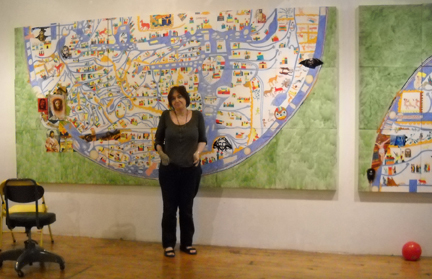
Joyce Kozloff in front of JEEZ. Photo: Deanna Sirlin.
Joyce
played an important part of the beginnings of the feminist art movement and was one of the main figures in the Pattern and
Decoration movement of the 1970s. But that is not why I am interested in her work. What interests me most about Joyce’s
work is the all-over quality of her compositions for the large-scale site works she has been making since the late 1970s.
These works incorporate glazed tile and mosaic. Although Joyce’s compositions and the shapes of the tiles she uses evoke
the traditional patterns she has studied in the harems and baths of Turkey and Morocco, her use of lighter and thinner color
is entirely personal. Joyce broke with the traditional palette of highly saturated and solid ultramarine blues, verdant greens
and alizarin crimsons, replacing them with oranges, pinks, and soft warm greens. The tile work is exquisite, but Joyce’s
physical and individual touch with the under glazes make clear that it is the work of an artist who wants to bring a fresh,
painterly approach to a traditional medium rather than that of a craftsperson who seeks simply to continue the tradition.
Given the chance, Kozloff’s work will take over a space. She has covered walls and floors and hearths and bathrooms
and anything or place that can be covered with her work to create a complete environment, an ambition I admire.
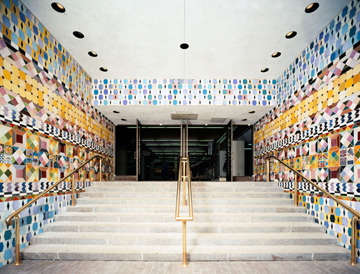
Joyce Kozloff,
Wilmington Train Station, 1984, Homage to Frank Furness. View from the street into the station. Glazed tile, 360 x 240 x 180”
There is, of course, something obsessive in an artist’s desire to fill a space with her imagery. But this obsessive
quality and Joyce’s attention to the articulation of form and, especially, color are among the many things that distinguish
her art from decoration, even in the work she refers to as “decorative art.” The tiles around her Cincinnati Fireplace,
1980, are in only two shapes, a star and a hexagon, which are repeated in the same pattern row after row. Examined closely,
however, each tile proves to be a world apart from its neighbors either by virtue of contrasting color or because of images
she painted into them. The repetition of the tiles and pattern is almost hypnotic, but the variations cause us to look at
individual tiles as well as the over-all effect and to perceive shapes made up of clusters of tiles that transgress their
linear arrangement. Joyce’s 1984 Wilmington Train Station entrance is based on a similar interplay of repetition and
difference, this time creating an immersive environment in three dimensions. At first, the tiles on the walls seem to be arranged
in horizontal bands distinguished by the size and shape of the tiles and by palette. Looking more closely, however, one starts
to see variations within the bands that give individual tiles identities that syncopate the overall rhythms. When my eye moves
around these fabulously decorated spaces, I feel transported to a kind of postmodern version of Topkapi Palace: there are
new palettes and a different sense of rhythm here, but the place has been imbued with similar opulence and the same sense
of pleasure of the place.
Like her work in tile, JEEZ, the giant painting Joyce was working on in her studio involves cultural appropriation.
It is based on the Ebstorf Map, a circular medieval map of the world from 13th century Germany twelve feet across painted
on thirty goatskins sewn together. Joyce has made her work the same size as the original. At the top of the original map is
the head of Christ. Joyce is reworking this image, including rivers and oceans, which she paints in a luminous light ultramarine
blue. In the original, a circular image of the world is inscribed in a square and surrounded by columns of text describing
the creation of the world. Joyce is replacing the text with multiple images of Jesus drawn from a vast array of art historical
sources. There are baby Jesuses and adult Jesues; thin Jesuses and fat Jesuses; black Jesuses and white Jesuses; medieval,
Renaissance, African, European Jesuses—even a Jesus that looks like the famous red poster of Che Guevara. There are
a total of a hundred and twenty-five Jesuses in the painting.
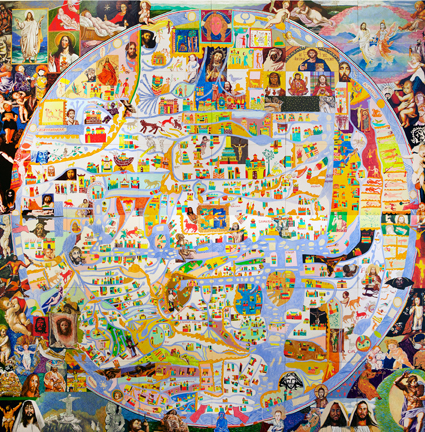
Joyce Kozloff,
JEEZ, 2012. Courtesy of the artist. Photo: Carmen Winant.
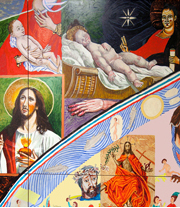
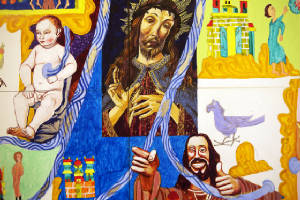
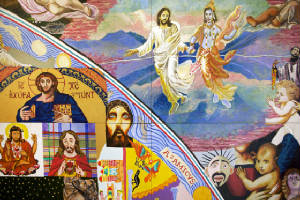
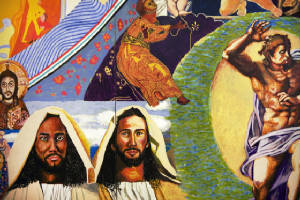
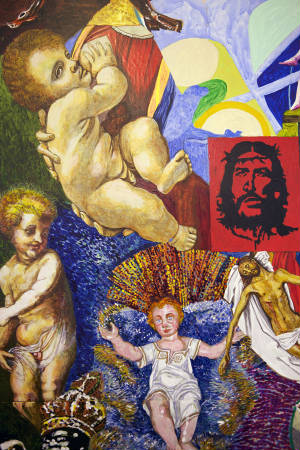
Details from JEEZ
In the upper left hand corner are two iterations of the "Baby Jeez,”
as Joyce humorously likes to call him. He is nude in both images, but he is presented very differently. The one on the further
left has his eyes open as a spigot of milk streams past him like some super natural laser beam of nature’s bounty. His
body is thin and angular. The second Baby Jeez is asleep, plump, and softly bathed in a painterly glow. The face of another
Jesus, standing above him, is painted like a totemic mask. Joyce’s cross-cultural articulation of the “Jeez”
is both a serious mediation on religious belief and cross-cultural representation and delightfully humorous. As she says,
“One usually sees just one at a time. It’s funny to see so many, like seeing a bunch of Santa Clauses on a street
corner.” My visit nearing its end, I decide to use the restroom before leaving Joyce’s studio. I open the door and
what is revealed is the most exquisite tile left over from other commissions on the walls of her bathroom. It is inlaid floor
to ceiling with colors ranging from red to orange to blues and purples, with floral drawing overlaid on a geometric pattern
of borders within borders. No harem bathroom could be more beautiful than this one that the artist made for herself and her
family. Here, Kozloff remixes her own work the way she has long mixed and juxtaposed artistic styles from multiple cultures
and centuries. It is as if her cross-cultural explorations and love of maps brought her home to this most personal space,
which she has transformed into a private world of seductive color. It is a wonder.

Joyce Kozloff, Shower. Photo: Deanna
Sirlin.
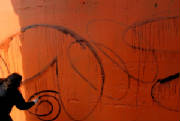
Deanna Sirlin is an artist based in Atlanta.
She is writing
a series of profiles for TAS of living American woman artists whose work she has been following.
|

